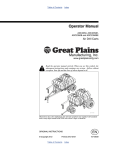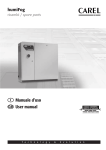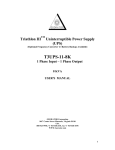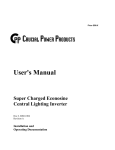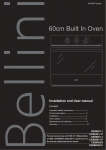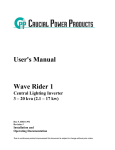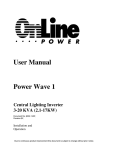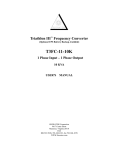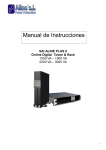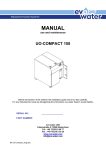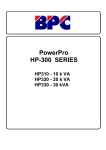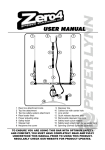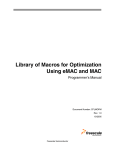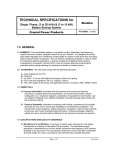Download User Manual - Perfect Power Systems
Transcript
User Manual Power Guard Emergency Lighting Inverter, Single Phase Document No. 6005-085P Revision C Installation and Operation *Due to continuous product improvement this document is subject to change without prior notice. NOTICE: This document contains PROPRIETARY INFORMATION. Reproduction or distribution FORBIDDEN! This document contains proprietary and confidential information of Perfect Power Systems, Inc. In consideration of the receipt of this document, the recipient agrees not to copy any of its contents, nor to disclose them to or allow them to be used by any person not currently an Perfect Power Systems employee or an employee of the recipient having a need to know, without the express written consent of Perfect Power Systems, and further agrees to surrender this document to Perfect Power Systems when the reason for its receipt has terminated. Due to continuous product improvement this document is subject to change without prior notice. © 2009 Perfect Power Systems, Inc. – All rights reserved I 6005-085P Rev D Congratulations on selecting one of the fine products from Perfect Power Systems, the leader in power protection technology. Our wide product offering includes UPS (Uninterruptible Power Systems), power conditioners, automatic voltage regulators and specialty transformers (e.g., computer-grade, medical-grade). Since our founding, Perfect Power Systems has shipped many of these fine products to discerning customers around the world for use on sensitive equipment and in critical applications. One of our goals is to make our manuals both comprehensive and easy to use. The new format of our user manual is the result of ideas and inputs from customers like you who have taken an active interest in our continued success. We invite and appreciate your feedback on our products and documentation via e-mail, fax, mail, or telephone. SALES Phone: (800) 786-6915 FAX No: (800) 246-2346 E-mail: [email protected] Office Hours are 7:00 AM to 5:00 PM PST WARRANTY REGISTRATION AND WARRANTY CERTIFICATE REQUEST www.800pwrsrvc.com SERVICE If you require assistance, please call our 24-hour toll free hot line 800-PWR-SRVC (800-797-7782) or email to [email protected]. Please have the following information from your unit’s nameplate available to speed assistance: Serial Number: KVA/Power Rating: Input Voltage: Output Voltage: Manufacturer Date: II 6005-085P Rev D IMPORTANT SAFETY INFORMATION! SAVE THESE INSTRUCTIONS Following safety precautions is important when operating or servicing electrical equipment. The symbols shown are used extensively throughout this manual. Always heed these precautions since they are essential to the safe operation and servicing of this product. Boxes labeled with “DANGER” indicate that there is a high risk of personal injury or death if instructions are not followed. Boxes labeled with “CAUTION” or “WARNING” indicates that there is a high probability of equipment malfunction, damage, or destruction if instructions are not followed. III 6005-085P Rev D Danger! ALL POWER TO THE UNIT MUST BE LOCKED AND TAGGED “OFF” BEFORE PERFORMING ANY SERVICE OR WORK ON THE UNIT. FAILURE TO DO SO COULD RESULT IN ELECTROCUTION. Danger! ONLY FACTORY TRAINED OR AUTHORIZED PERSONNEL SHOULD ATTEMPT TO INSTALL OR REPAIR THE UNIT OR ITS BATTERY SYSTEM. IMPROPER INSTALLATION HAS PROVEN TO BE THE SINGLE MOST SIGNIFICANT CAUSE OF START-UP PROBLEMS. HIGH AC AND DC ELECTRICAL VOLTAGES ARE PRESENT THROUGHOUT THE UNIT (S) AND INCORRECT INSTALLATION OR SERVICING COULD RESULT IN ELECTROCUTION, FIRE, EXPLOSION, OR EQUIPMENT MALFUNCTION. Danger! ALL POWER CONNECTIONS MUST BE COMPLETED BY A LICENSED ELECTRICIAN WHO IS EXPERIENCED IN WIRING THIS TYPE OF EQUIPMENT. WIRING MUST BE INSTALLED IN ACCORDANCE WITH ALL APPLICABLE NATIONAL AND LOCAL ELECTRICAL CODES. IMPROPER WIRING MAY CAUSE DAMAGE TO THE EQUIPMENT, INJURY OR DEATH OF PERSONNEL. VERIFY THAT ALL HIGH AND LOW VOLTAGE INPUT POWER CIRCUITS ARE DE-ENERGIZED AND LOCKED OUT BEFORE INSTALLING CABLES OR MAKING ANY ELECTRICAL CONNECTIONS. Danger! IN CASE OF FIRE INVOLVING ELECTRICAL EQUIPMENT, ONLY USE CARBON DIOXIDE FIRE EXTINGUISHERS, OR THOSE APPROVED FOR USE ON ELECTRICAL EQUIPMENT SHOULD BE USED. USE OF WATER ON FIRES INVOLVING HIGH VOLTAGE ELECTRICAL CIRCUITS COULD PRESENT AN ELECTROCUTION HAZARD. IV 6005-085P Rev D Danger! TEST LIFT AND BALANCE THE CABINETS BEFORE MOVING. MAINTAIN MINIMUM TILT FROM VERTICAL AT ALL TIMES. THE BOTTOM STRUCTURE WILL SUPPORT THE UNIT ONLY IF THE FORKLIFT FORKS ARE COMPLETELY UNDERNEATH THE UNIT. Danger! BE CONSTANTLY AWARE THAT THE UNIT SYSTEM CONTAINS HIGH DC AS WELL AS AC VOLTAGES. WITH INPUT POWER OFF AND THE BATTERY DICONNECTED, HIGH VOLTAGE AT THE FILTER CAPACITORS AND POWER CIRCUITS SHOULD DISCHARGE WITHIN 30 SECONDS. HOWEVER, POWER CIRCUIT MALFUNCTIONS CAN OCCUR, SO YOU SHOULD ALWAYS ASSUME THAT HIGH VOLTAGE MIGHT STILL EXIST AFTER SHUTDOWN. VERIFY THAT POWER IS OFF USING AC AND DC VOLTMETERS BEFORE MAKING CONTACT. Danger! LEAD-ACID BATTERIES CONTAIN HAZARDOUS MATERIALS. BATTERIES MUST BE HANDLED, TRANSPORTED, AND RECYCLED OR DISCARDED IN ACCORDANCE WITH FEDERAL, STATE, AND LOCAL REGULATIONS. BECAUSE LEAD IS A TOXIC SUBSTANCE, LEAD-ACID BATTERIES SHOULD BE RECYCLED RATHER THAN DISCARDED. DO NOT DISPOSE OF BATTERIES IN A FIRE, THE BATTERIES MAY EXPLODE. DO NOT OPEN OR MUTILATE THE BATTERIES. THE SKIN AND EYES AND MAY BE TOXIC. RELEASED ELECTROLYTE IS HARMFUL TO A BATTERY CAN HAVE A HIGH SHORT CIRCUIT CURRENT AND PRESENT A RISK OF ELECTRICAL SHOCK. THE FOLLOWING PRECAUTIONS SHOULD BE OBSERVED WHEN WORKING ON BATTERIES: 1. REMOVE WATCHES, RINGS OR OTHER METAL OBJECTS. 2. USE TOOLS WITH INSULATED HANDLES. 3. WEAR RUBBER GLOVES AND BOOTS. 4. DO NOT LAY TOOLS OR METAL PARTS ON TOP OF BATTERIES. 5. DISCONNECT CHARGING SOURCE PRIOR TO CONNECTING OR DISCONNECTING BATTERY TERMINALS. 6. DETERMINE IF BATTERY IS INADVERTENTLY GROUNDED. IF SO, REMOVE THE SOURCE OF THE GROUND. CONTACT WITH ANY PART OF A GROUNDED BATTERY CAN RESULT IN ELECTRICAL SHOCK. THE LIKELIHOOD OF SUCH SHOCK WILL BE REDUCED IF SUCH GROUNDS ARE REMOVED DURING INSTALLATION AND MAINTENANCE. 7. LEAD-ACID BATTERIES CAN PRESENT A RISK OF FIRE BECAUSE THEY GENERATE HYDROGEN GAS. THE FOLLOWING PROCEDURES SHOULD BE FOLLOWED: 8. 1. DO NOT SMOKE WHEN NEAR BATTERIES. 2. DO NOT CAUSE FLAME OR SPARK IN BATTERY AREA. DISCHARGE STATIC ELECTRICITY FROM YOUR BODY BEFORE TOUCHING BATTERIES BY FIRST TOUCHING A GROUNDED SURFACE. V 6005-085P Rev D TABLE OF CONTENTS SECTION PAGE SECTION 1 – INTRODUCTION 1 SECTION 2 – SYSTEM DESCRIPTION 1 2.1 General Description 1 2.2 System Configuration 3 SECTION 3 – SAFETY INFORNATION 4 SECTION 4 – STORAGE 5 SECTION 5 – INSTALLATION 5 5.1 Environment 5 5.2 Installation Layout 6 5.3 Input/Output/Load Connection 7 SECTION 6 – OPERATION 8 6.1 System Description 8 6.2 Operation / Turn on Procedure 9 SECTION 7 – TROUBLE SHOOTING 13 7.1 Trouble Shooting Chart 13 7.2 UPS status and actions 14 SECTION 8 – OPERATION MODES 15 8.1 Block Diagram 15 8.2 Normal Operation 15 8.3 AC Utility Failure 16 8.4 Bypass Enable 16 SECTION 9 – COMMUNICATONS 17 9.1 Communication Interface 17 9.2 DB9 PIN Assignment 17 SECTION 10 – OPTIONS 18 SECTION 11 – TECHNICAL SPECIFICATIONS 20 VI 6005-085P Rev D INSTRUCTIONS Special Symbols The following symbols are used on the UPS to alert you of safety related issues: RISK OF ELECTRIC SHOCK – Please observe the warning that a risk of electric shock is present. CAUTION: REFER TO OPERATOR’S MANUAL - Refer to the operator’s manual for additional information, such as important operating and maintenance instructions. SAFE GROUNDING TERMINAL - Indicates primary safe ground LOAD ON/OFF - Pressing this button turns on/off the output receptacles and the Indicator light. RJ-45 RECEPTACLE - The receptacle provides network interface connections and telephone or telecommunications equipment should not be plugged into it. Please do not discard the UPS or UPS batteries as the UPS may have valve regulated, lead–acid batteries. Please recycle batteries. VII 6005-085P Rev D 1. Introduction The information provided in this manual is applicable to single phase 500-2100watt uninterruptible power systems, their basic functions, operating procedures, and emergency procedures. It also includes information on how to ship, store, handle and install the equipment. This manual also provides detailed requirements for the safe installation and use of the UPS. Installation must be carried out in accordance with this manual. Electrical installations must also carefully follow local code and regulations. Only qualified personnel should install or maintain this equipment as failure to follow safety procedures or recognize electrical hazards could result in damage to the equipment and property, injury or even death: Important Notice: Read the following before proceeding: a. b. c. d. e. f. g. Read instructions carefully before operating the UPS. UPS power connect instruction should be followed. ELECTROCUITION DANGER! Do not open the case. If the UPS will be stored for a long period, the battery must be charged once every 90 days. Maintain the load within the rating of UPS to prevent faults. Handle unusual events according to the trouble-shooting guide. Keep the UPS clean and dry. 2. System description Your new UPS (Uninterruptible Power System) will protect your electronic and electrical equipment such as computers, workstations, process control systems, telecommunications systems, sales terminals and other critical instrumentation from unstable or otherwise poor quality utility power, power failure, and other adverse events.. Electrical interference abounds in many forms and can cause unreliable operation of your critical equipment. Sources of interference include, but are not limited to, utility company generated fluctuations and noise from such diverse sources as lightning equipment, radio frequency interference from worn or damaged motor brushes, air conditioners, vending machines, appliances and even arcing across insulators on utility poles. Additionally, power failures, low or high voltage, voltage surges and fluctuations, frequency variations, differential and common-mode noises and transients. All must be addressed to ensure continual and reliable operation of your vital equipment Your new UPS will help prevent those issues from affecting your systems and causing damage or malfunction of your critical equipment including computer hardware and sensitive software by maintaining a consistently clean power source, isolating critical load output if needed, and filtering noise from your facilities AC power while providing an uninterrupted stream of backup power in the event of a utility power failure. 2.1 General description Your new double conversion on-line UPS is able to supply uninterrupted, clean, single-phase power to your critical systems while keeping batteries continuously charged and provide a back up in the even of a utility power failure. If a power failure lasts longer than the rated UPS backup time, your UPS will shut down systematically, avoiding battery discharge. As soon as utility power is restored, the UPS will automatically switch to utility power and start recharging the batteries. As shown in the block diagram, Figure 1: An input filter reduces transients on the mains To maintain full battery charge, AC-power is rectified and regulated in the rectifier feeding power to the inverter and battery converter. DC power is converted to AC in the inverter passing it on to the load. Power is maintained from the battery during a power failure. The converter increases voltage appropriately for the inverter. 8 6005-085P Rev D Fig.1. Block diagram Efficiency Optimizer function The Efficiency Optimizer Function is a new feature of your UPS that adds cost effectiveness, provides minimal power loss and reduced power consumption. Alternating between bypass and on-line modes is achieved automatically and in accordance with the conditions of the utility power. In order to obtain greatest efficiency, on-line mode may function during times of intermittent utility power availability and bypass mode when power flows smoothly. Irregularities can be detected in less than a second, and on-line mode reactivated immediately. Switching back to online mode occurs when the input voltage exceeds ±10% of nominal (±15% selectable), when the input frequency exceeds ±3Hz of nominal or when no input line voltage is detected. An available option allows default operation in the on-line mode. Bypass can be activated from the LCD panel, though on-line mode can be run permanently if preferred. Free Run Mode The UPS operates in free run mode when the input frequency is outside of the selected input frequency range. In free run mode the output frequency does not match input frequency. When starting the UPS, the frequency regulation detected is 50 or 60 Hz ±0.25Hz. Diagnostic tests When you start the UPS, a diagnostic test is automatically executed that checks the electronics and battery and reports any faults on the LCD display. An advanced battery management system always monitors the conditions of the batteries and sends a warning if replacement is needed. Otherwise every 30 days of normal mode operation, a battery discharge test is automatically performed and any faults are reported on the LCD display. Diagnostic tests can be performed manually from the front panel at any time except during the first 24-hours after startup while the UPS is in the charging mode. 9 6005-085P Rev D 2.2 System Configuration The UPS system is composed of an electronically controlled switching and power conditioning system and batteries housed in the same enclosure for lower capacity systems and in multiple cabinets for large capacity systems. .Depending on the site and load requirements of the installation, certain additional options are available to customize the system to your specific needs. When planning a UPS system, the following should be taken into consideration: The total worst case electrical load of the anticipated protected system must dictate the output power rating (Watts). Allow for future expansion from the measured or calculated power requirements along with a margin for error. The backup time at the indicated power rating is 90 minutes. The following options are available: Auxiliary circuit breakers (up to 12). Maintenance bypass switches. External auxiliary TVSS (UL1449 3rd edition) Connectivity options (relay card, SNMP/WEB card). The following UPS models are available Power Guard (Battery 96 VDC unit) 10 6005-085P Rev D 3. Safety Information If you have not yet read the UPS safety manual, please do so now. Installation CAUTION! Storage and Transportation Electrocution Hazard Please handle with extreme caution since a high amount of energy is contained within the batteries. Always keep the unit positioned as marked on the packaging and never jolt or drop the unit. CAUTION! Explosion Hazard If flammable substances such as gases or fumes are present or if the room is not ventilated, a safety hazard situation exists, in which no electrical equipment should be operated. CAUTION! The instructions in this manual explain how to install the UPS safely. Not observing electrical hazards may be fatal, so keep this manual for future reference. . DANGER! Electrocution Hazard Do NOT open the UPS cabinet! Very high voltage may be present even with the power turned off. Contact with internal components may cause injury or death. Only a technician from the manufacturer or an authorized agent should ever service the unit. The output receptacles on this UPS retain high voltage even when not connected to utility power since it has its own energy source (the batteries) 11 6005-085P Rev D User’s operations CAUTION! To ensure safety, only the following operations should be performed by users. All such operations must be performed exactly as instructed in this manual and any change from the protocol shown may prove very hazardous to the operator. ALL OTHER OPERATION OR MAINTENANCE MUST BE PERFORMED BY QUALIFIED TECHNICAL PERSONAL ONLY! To ensure safety, the only operations that users are permitted to do are: Turn the UPS unit on and off Operate the user interface Connect data interface cables 4. Storage If the UPS is not installed immediately, you must store the unit in accordance with the following instructions to avoid damage which could void your warranty: Store the equipment as is in its original packing and shipping carton. Do not store in temperatures exceeding the specified range of +32° F (-20°C) to +122° F (+50°C). Ensure that the equipment is fully protected from moisture, salts, dirt, dust and relative humidity exceeding 95% non-condensing. In order to prevent battery deterioration, ensure that the UPS is recharged every 6 months for at least 8 hours. 5. Installation 5.1 Environment WARNING! To protect the safety of personnel, ensure that all environmental and functional requirements for UPS location are met according to these technical specifications. 12 6005-085P Rev D Ensure that you follow these instructions when positioning the UPS system and battery options: Avoid extremes of temperature and humidity in accordance with the specifications in Section 11 of this manual. Maximum battery life can be attained with a recommended temperature range of +59° F (+15°C) to +77° F (+25°C). Ensure that the equipment is fully protected from dirt and dust which can clog filters and allow arcing, which will damage the equipment. Ensure that the front of the UPS remains clear for safe user operation. Space and ventilation requirements must be met (see below). 5.2 Installation Layout: Shown with floor mounting brackets 2” Clearance 13 6005-085P Rev D 5.3 Input/Output/Load Connection Breaker SYTEM RATING (WATTS) (BATTERY TYPE) (BATTERY TYPE) TORQUE (INCH LBS) TORQUE (INCH LBS) 500W (UB12260) 59 IN-LB HP12-116W-XFR (55 IN-LB) 750W (UB12350) 59 IN-LB HP12-116W-XFR (55 IN-LB) 1000W (UB12350) 59 IN-LB 1250W (UB12500) 59 IN-LB 1500W (UB12550) 59 IN-LB 2100W (UB12750) 59 IN-LB The installation is now complete. 14 6005-085P Rev D 6. Operation 6.1 System Description Follow the instructions below for the UPS operation. Switch Function (4) ON-OFF CONTROL KEY When this key is pressed with the LCD Select Down-Key simultaneously for 3 seconds, the UPS will switch on if the unit is not in the battery back-up mode. Press both the ON-OFF Control key and LCD Select UP-key at the same time to disable the beeps. (2) SELECT UP-KEYS Press up to select the UPS status on LCD Display. Press with the LCD Select Down-key simultaneously for 3 seconds to turn off the UPS. (3) SELECT DOWN-KEY (1) LCD DISPLAY Press down to display the UPS Status. (5) FAULT LED The red LED indicates that the UPS is in a fault condition because of inverter abnormality, over-temperature or DC_BUS fault. (6) WARNING LED (7) NORMAL LED The yellow LED indicates that the UPS is overloaded, in bypass or battery back-up mode. This LCD Display shows UPS operation information, including UPS status, input/output voltage, input/output frequency, battery voltage, battery capacity remaining, output load, inside temperature, and the historical event log with the time of each event. Additionally, the UPS output voltage and output frequency can be set from the LCD panel. The green LED illuminates when the UPS is operating normally. 15 6005-085P Rev D 6.2 Operation/Turn-on Procedure Please follow the instructions below for UPS operation. Starting and shutting down the UPS Ensure that unit was correctly installed in accordance with all building and safety codes and that the input power cable is connected to a tested well-grounded outlet. 1. SWITCH THE EXTERNAL INPUT BREAKER TO "ON" AND CHECK THE VOLTAGE AT THE "INPUT AC TERMINAL" 2. SWITCH THE INTERNAL UPS INPUT BREAKER TO "ON" 3. TURN THE BATTERY BREAKER TO "ON" 4. PRESS POWER BUTTONS LOCATED ON THE FRONT DISPLAY 5. SWITCH THE OUTPUT BREAKER(S) TO "ON" During this inspection, the LCD will display “Ready on”. The LED will light up when the output power is available and the LCD will display “Line mode.” Switch on the loads. Shutting down the UPS 1. SWITCH THE OUTPUT BREAKER(S) TO "OFF" 2. SWITCH THE BATTERY BREAKER TO "OFF" 3. SWITCH THE INPUT BREAKER TO "OFF" WELCOME TO USE UPS LCD display By pressing the UPS ON/OFF Control Key and the LCD Select Down-key simultaneously for 3 seconds until the buzzer beeps twice, the UPS will start up and the Normal LED will illuminate to indicate that the power is flowing from the inverter to the load. When the LCD Select Down-key and the LCD Select Up-key are pressed simultaneously for 3 seconds until the buzzer beeps twice, the inverter will turn off and the UPS will enter standby status (LCD display illuminates and Normal LED is blinking) until the AC source is disconnected. 16 6005-085P Rev D 1. Status Menu: 2. Voltage Menu: 3. Frequency Menu: 17 6005-085P Rev D 4. Battery Status Menu: 5. V Output Power Menu 6. 7. Temperature Menu: History Record Menu: 18 6005-085P Rev D 8. Bypass Range Set Menu: a. To protect the load, the function of bypass auto-transfer is activated only when the AC main voltage is within the range of LO (low) and HI (high). In this screen, press the ON/OFF Control key to enter the following steps for LO/HI voltage setting: b. The cursor ( ) will appear to indicate the selected item. Press the ON/OFF Control key to find the LO or HI range display. c. Use the Up or Down key to adjust the voltage (1V for every press) to the desired setting. d. Once the value is confirmed, press the ON/OFF Control key again to save the data: 19 6005-085P Rev D 9. Output Voltage and Frequency Adjustment Menu: a. Press the ON/OFF Control key to set the output voltage or frequency. b. The cursor ( ) appears to indicate the selection of output voltage or frequency. c. Use Up or Down key to adjust the output voltage to 220V, 230V or 240V for 220V systems or 100V, 110V, 115V or 120V for 120V systems. The output frequency can be set to 50Hz or 60Hz. d. Once the correct voltage or frequency is selected, press the ON/OFF Control key again to save the data. 20 6005-085P Rev D 7. Trouble Shooting Failure of a UPS is rare. However, if you should experience difficulties, this Trouble Shooting Guide, should help you quickly resolve the majority of issues. 7.1 Trouble Shooting Chart 21 6005-085P Rev D 7.2 UPS Status and Actions The following guidelines may be helpful for problem resolution: UPS Status Action AC utility power is normal. UPS is running normally, but battery capacity is low and the. alarm beeps once every second for battery low. Charger may have failed – Replace the Charger Board. AC utility power is normal. The output load is supplied through bypass of the AC utility. The Fault LED illuminates and the alarm sounds continuously. Contact your agent for service. AC utility power is normal, but the UPS is overloaded. The Warning LED is illuminated and the alarm beeps every second. Reduce the critical load on the UPS to its rated capacity (The unit’s load capacity can be found on the nameplate attached to the door of the UPS). AC utility power is normal, but the UPS is overloaded up to 125%. The Warning LED does not fade out and the alarm beeps at ½-second intervals. Reduce the critical load on the UPS to its rated capacity (The unit’s load capacity can be found on the nameplate attached to the door of the UPS). The UPS is supplying normal AC utility power via the bypass mode. The output power is more than 150% and the Warning LED is illuminated while the alarm sounds continuously. Reduce the critical load on the UPS to its rated capacity (The unit’s load capacity can be found on the nameplate attached to the door of the UPS). AC utility power fails. The load is supplied If AC utility power fails, reduce the less then by battery power and the alarm sounds every critical load as soon as possible to extend the 4 seconds. backup time. If measurement shows that AC utility power is present on the input, check the rated input to verify that it is within specifications. AC utility fails. UPS is in battery backup mode and battery power is approaching discharge. Buzzer alarm beeps every second. UPS will shut down automatically when the battery reaches its discharge limit. To avoid data loss, save your data without delay. AC utility power fails and the battery drains below the minimum level. The UPS has shut down automatically. The UPS will automatically restart when the AC utility power is restored. If the AC utility power failure exceeds 6 hours, it is important to follow the storage instructions in Section.4 of this manual. 22 6005-085P Rev D 8. Operation Modes: 8.1 Block Diagram: Single line block diagram of units with 120V Input/Output Single line block diagram of units with 120V Input/Output Single line block diagram of units with 277V Input/Output 23 6005-085P Rev D 8.2 Normal Operation: There are two main loops when AC utility is Normal. • The AC loop The AC output power comes from AC utility input and passes through AC/DC rectifier, DC/AC inverter and static switch to support power to the load. • Battery charging loop The battery charging voltage comes from the AC utility input and is converted by the AC/DC charger to support battery charging power. 8.3 AC utility failure: The AC output power comes from the battery, passes through the DC/AC Inverter, DC/AC Inverter and the Static Switch to provide power to the load. The battery charging path is from the AC utility input to the AC/DC Charger to charge the battery. 24 6005-085P Rev D 8.4 Bypass Enable: Under the Following Conditions, the bypass will be enabled: 1. Overload 2. Inverter failure 3. Over temperature 4. DC bus failure 9. Communication 9.1 Communication interface The communication interface (DB9 port) on the back of the UPS may be connected to a host computer to provide the following external control:. 1. Supply dry contact function to the UPS using software such as Megatec RUPS, which communicates with the computer by supplying simulation of relay closure. Its major functions include: a. Broadcasting a warning when power fails b. Closing any open files before the battery is exhausted. c. Turning off the UPS. 2. Supply and RS-232 interface for monitoring software such as Megatec RUPSII or UPSilon 2000. 25 6005-085P Rev D The UPS communicates with the computer by sending an RS-232 data streams to one of the serial ports, which allows the user to monitor the following parameters: Input Voltage: Output Voltage: Battery Voltage: Temperature: Indicates the present input voltage to the UPS system when power is present. Indicates the present output voltage of the UPS. Indicates the present DC voltage of the UPS battery. Indicates the actual temperature inside the UPS. 9.2 DB9 PIN Assignment PIN 2: RS232 RXD PIN 3: RS232 TXD PIN 5: GND The other pins have no function DB9 INTERFACE CONNECTOR 10. Options 10.1 Auxiliary Norm ON C.B options,1pole, 20amp (maximum of 12 each) 10.2 Auxiliary Norm OFF or Norm ON W/ delay C.B options, 1pole, 20amp (maximum of 12 each) 10.3 MBS ( Maintenance By-pass Switch – manual) 10.4 Auxiliary TVSS 10.5 Floor Mounting Brackets 10.6 Communication Interface (RS232, USB) 10.7 SNMP/WEB Card or AS400C W/ Relay Card 10.8 Remote Status Panel (Remote Monitor) 10.9 AS400 Relay Card is used to provide potential free relay contact interface for those industrial control applications that require dry contact signals. 26 6005-085P Rev D DB9 Pin Assignments: DB9 Pin # Description of Functionality Input or Output 1 UPS Failure Output 2 Summary Alarm Output 3 Ground 4 Remote Shutdown 5 Common 6 Bypass Active Output 7 Battery Low Output 8 UPS On Output 9 Utility Failure Output Input Functionalities of the DB9 Pins: Status Description of Functionality Reason /Cause PIN 1 & PIN 5 Closed UPS failure UPS Internal Fault PIN 2 & PIN 5 Closed Summary Alarm 1. UPS on Battery Mode 2. Battery Voltage Low 3. UPS Internal Fault PIN 3 GND, For External Ground PIN 4 Remote Shutdown PIN 5 Common PIN 6 & PIN 5 Closed Bypass Active UPS on Bypass Mode PIN 6 & PIN 5 Open UPS On UPS on Inverter Mode PIN 7 & PIN 5 Closed Battery Low Battery Voltage Low PIN 8 & PIN 5 Closed UPS On UPS on Inverter Mode PIN 8 & PIN 5 Open Bypass Active UPS on Bypass Mode PIN 9 & PIN 5 Closed Utility Power Failure Utility Power Failure 27 Remote Shutdown Command 6005-085P Rev D DB9 Internal Wiring Diagram: Internal Wiring from the UPS to the DB9 Connector AS400 Relay Card Application User Interface Wiring Diagram: External Interface connection at the DB9 Connector 28 6005-085P Rev D 11. Technical Specification Specifications for 120VVAC /277VAC Capacity (W) Description 500 Voltage Input 750 1000 Voltage Range 2100 120Vac ±10% or or 277Vac 60Hz +/- 4Hz Voltage (on battery) Single Phase 120Vac or 277Vac Voltage Range 120Vac ±2% or 277Vac Frequency (on battery) 60 Hz +/-0.5% Transfer Time 0 ms Overload Recovery Auto transfer to UPS High Efficiency mode (AC to AC) UPS Design Technology Protection and Filtering 1500 Single Phase 120Vac or 277Vac Frequency Output 1250 > 95 % On-Line / Fully digitized microprocessor controlled Output Wave Form Sine wave Harmonic distortion < 3% of T.H.D. at linear load Overload Protection 125% for 1 minutes and 150% for 10 seconds Short Circuit Protection Circuit breaker Visual Display UPS on(green), line-mode(green), (LED model) battery mode(yellow), bypass(yellow), fault(red) Visual Display System/Display/ (LCD model) Warning Audible Alarm Input / output voltage, input / output frequency, on-line mode, back up mode, battery capacity, load level Beep every 5 sec (Battery back-up) UPS Fault Continuous beeping sound and LCD display Communication RS-232 Serial Port and USB Battery 90 min. UL924 (Sealed, maintenance 8X26 A/H 8X35 A/H 8X35 A/H 8X50 A/H 8X65 A/H 8X65A/H free lead acid battery Dimensions (Inches) Width x Height x Depth Environmental 23.5 X 34.25 X 18.25 Operating Temperature 0 - 40ºC / 32 ~ 104ºF Storage Temperature -20 ~ 50ºC / -4 ~ 122ºF Audible Noise < 40 dBA (1 meter from surface) Relative Humidity 0 ~ 95% humidity, non-condensing Note: Due to continuous improvement, specifications are subject to change without prior notice. 29 6005-085P Rev D
































